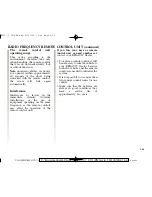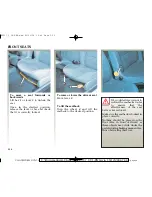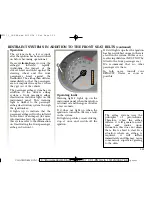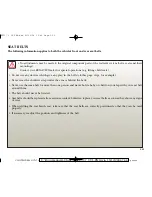
1
2
NU737_3_G1-FRA.qxd 29/11/04 11:46 Page 1.11
CLIO-TRICORPS NU737-3
C:\Documentum\Checkout\NU737_3_T1-ENG.win 15/12/2004 7:44
- page 19
1.11
SEAT BELTS
Always wear your seat belt when
travelling in your vehicle. You must
also comply with the legislation of
the particular country you are in.
Before driving off:
- first ensure that your driving
position is correct
- then adjust your seat belt to
provide maximum protection.
Incorrectly adjusted seat
belts may cause injuries
in
the
event
of
an
accident.
Even pregnant women should
wear
a
seat
belt.
In
this
eventuality, ensure that the lap
belt is not exerting too much
pressure on the abdomen but do
not allow any slack.
Adjusting your driving position
•
Sit well back in your seat
(having
removed your coat or jacket).
This is essential to ensure your
back is positioned correctly.
•
Adjusting the distance between
the seat and the pedals.
Your seat should be as far back as
possible while still allowing you
to be able to fully depress the
clutch pedal. The seatback should
be adjusted so that your arms are
slightly bent when you hold the
steering wheel.
•
Adjusting the position of your
headrest.
For safety reasons, the top of your
head should be in line with the
top of the headrest.
•
Adjusting the height of the seat.
This adjustment allows you to
select the seat position which
offers you the best possible
vision.
•
Adjust the position of the steering
wheel.
Adjusting the seat belts
Sit with your back firmly against the
seatback.
Shoulder strap 1 should be as close
to the base of your neck as possible
but not on it.
The lap strap 2 should be worn flat
over your thighs and against your
pelvis.
The seat belt should be worn as
close to your body as possible;
avoid wearing clothes that are too
thick, or holding any objects that
could obstruct the seat belt, etc.
















































